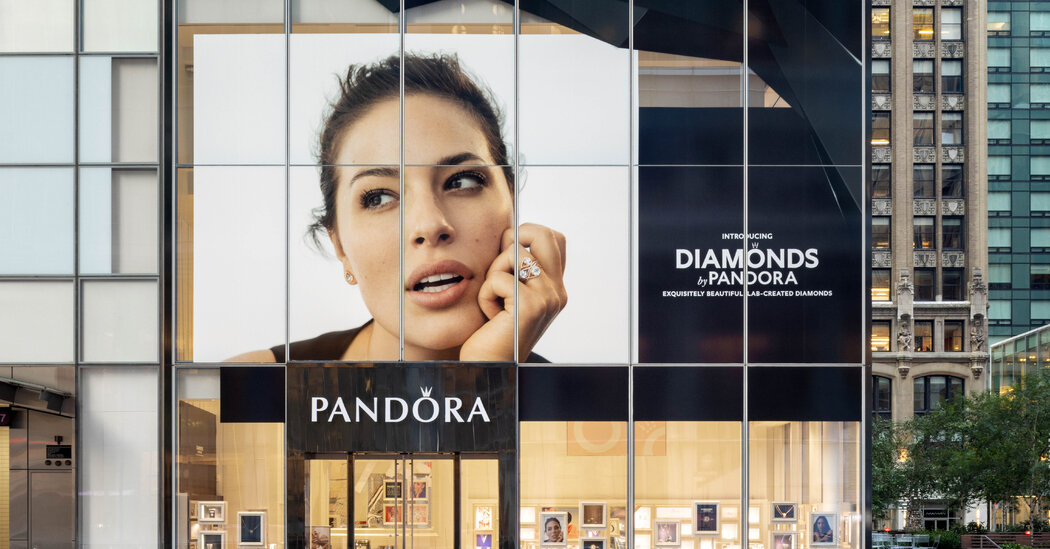
Pandora, the world’s largest jewelry company by volume, is on a mission.
Known for its sterling silver charms, made to be strung in great numbers on the company’s bracelets, Pandora has been in danger of becoming what Karen Giberson, president and chief executive of the New York-based Accessories Council called a “one-hit wonder.” It needed to diversify.
So in August the brand introduced Brilliance, its first collection in the Diamonds by Pandora initiative, in the United States and Canada. The line, featuring lab-grown diamonds in rings, bracelets, necklaces and earrings, debuted in a pilot program in 2021 in Britain and now is available for sale online as well as in stores in all those locations.
“Pandora became known for charms,” Luciano Rodembusch, president of Pandora North America, wrote in an email, “and now we see the opportunity to evolve that into being a jewelry company that also sells charms.”
In May 2021, Pandora announced that it would no longer use mined diamonds in any new designs and would switch to lab-grown gems. Marketing materials for the Copenhagen-based business said the lab-grown gems “have the same optical, chemical, thermal and physical characteristics” as the mined versions.
Sustainability has become a prime talking point in the jewelry industry, and while advocates consider lab-grown diamonds a more environmentally conscious option than mined stones, others say that the vast amount of energy needed to produce them creates problems of its own. Pandora said its gems were provided by a supplier, which it declined to name, but its marketing materials said the “lab-created diamonds are grown, cut and polished using 100 percent renewable energy and have a carbon footprint of only 5 percent of that of mined diamonds.”
Also, the Brilliance jewelry “is set in recycled gold and silver, so we also bring added benefits for consumers and the planet,” Alexander Lacik, Pandora’s chief executive, wrote in an email. The brand has said its recycled metals meet the Responsible Jewellery Council’s Chain of Custody standard.
A. Filippo Ficarelli, one of Pandora’s two creative directors, said that the Brilliance collection “is grounded in making high-quality diamond jewelry more affordable and available to more people.”
“It is for everyone, for all people,” he said.
Prices range from $300 for a sterling silver bracelet with a 0.15-carat diamond and to $4,450 for a 2-carat diamond ring in 14-karat white gold or 14-karat yellow gold.
“Our mission is to democratize jewelry,” Mr. Lacik wrote, “placing us in the affordable luxury segment.
“This is taken to the next level with our lab-created diamond jewelry, making this item that is perceived as a luxury item for the few available to a broader group of customers.”
The design of the Brilliance jewelry — adapting the infinity symbol, which looks like the number 8 lying on its side — also carries a message, Francesco Terzo, the other creative director, wrote in an email. “Diamonds are meaningful and we want to add more to the stone, which led us to the modern interpretation of a timeless infinity motif,” he wrote.
Pandora has made previous efforts to vary its product line. In 2015 it offered Timeless, a collection featuring charms and jewelry highlighted with pavé cubic zirconia or colored crystals. In 2019, the Pandora ME line debuted with chain bracelets, stacking rings and charms, as well as pieces like link earrings and necklaces that could be adorned with charms. And in 2021 there was a formal introduction of the Signature collection, with charms and bracelets in gold, rose gold and silver, as well as ID bracelets, earrings and rings.
But charms figured in all three of those collections and are expected to provide 70 percent of the company’s sales this year. So, “we have an aim to create more balance of our charms versus jewelry offerings,” Mr. Lacik wrote.
Last year Pandora reported revenue of $3.1 billion from the sale of 102 million pieces of jewelry, the result of more than 670 million visits to its online site and physical stores. It has 6,400 points of sale, including 2,400 concept stores, in more than 100 countries.
The company intends to grow those numbers with the new Brilliance collection and other Diamonds by Pandora offerings, but without changing its basic strategy.
“We service the mass consumer,” Mr. Lacik wrote. “We don’t play in the lower end of the jewelry market nor do we strive to play in the high-end of the market. Pandora is firmly a brand for the masses. That is why we are the biggest jewelry company in the world.”






